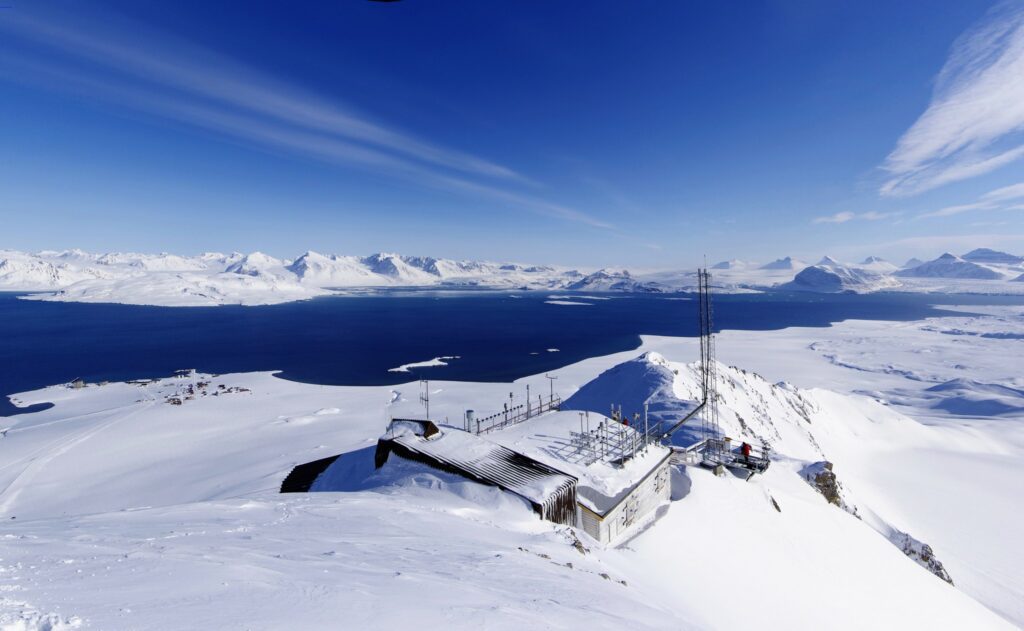Zeppelin Observatory in Ny-Ålesund, Spring 2018. Photo: christelle Guesnon
New publication from year-round monitoring at the Zeppelin Observatory during MOSAiC
Written by
Ingrid Kjerstad,
Research coordinator/The Norwegian Polar Institute
03.10.2024
This September a new article from researchers at the National Institute of Polar Research (NIPR), Meteorological Research Institute (MRI), Nagoya University, the University of Tokyo, and Norwegian Institute for Air Research (NILU) has been published in the Nature Journal Communications Earth & Environment (link below) based on data gathered at the Zeppelin Observatory in Ny-Ålesund Research Station. This research was performed in the framework of the Atmosphere and Terrestrial Ecosystems Flagships.
The year-round measurements during the MOSAiC project in 2019/20 provide insights into the warming-driven changes in the population of natural aerosols serving as ice nucleating particles (INPs) in the Svalbard region, and the article suggests that highly active INPs could be actively released from Arctic natural sources in response to surface warming (Tobo, Y. et al., 2024).
The Svalbard region is recognized as one of the most climatically sensitive regions in the world, and recent studies have reported that the largest warming takes place over the Eurasian sector of the Arctic Ocean near Svalbard and Novaya Zemlya (Isaksen, K. et al., 2022; Rantanen, M. et al., 2022).
Read the open access article in Nature here:
Surface warming in Svalbard may have led to increases in highly active ice-nucleating particles (Tobo, Y., Adachi, K., Kawai, K. et al. Surface warming in Svalbard may have led to increases in highly active ice-nucleating particles. Commun Earth Environ 5, 516 (2024). https://doi.org/10.1038/s43247-024-01677-0)
See also the press release from NIPR for more information about this work!
Looking for a scientific network within atmospheric or terresterial research in Ny-Ålesund? Check out the Atmosphere and Terrestrial Ecosystems Flagship programs:
References:
Isaksen, K., Nordli, Ø., Ivanov, B. et al. Exceptional warming over the Barents area. Sci Rep 12, 9371 (2022). https://doi.org/10.1038/s41598-022-13568-5
Rantanen, M., Karpechko, A.Y., Lipponen, A. et al. The Arctic has warmed nearly four times faster than the globe since 1979. Commun Earth Environ 3, 168 (2022). https://doi.org/10.1038/s43247-022-00498-3
Tobo, Y., Adachi, K., Kawai, K. et al. Surface warming in Svalbard may have led to increases in highly active ice-nucleating particles. Commun Earth Environ 5, 516 (2024). https://doi.org/10.1038/s43247-024-01677-0
The Zeppelin Observatory

The Zeppelin Observatory is located on the Zeppelin Mountain, 472 meters above sea leavel where local pollution is minimal.
The Zeppelin Observatory is part of a global network of observatories for atmospheric measurements, and is part of several regional and global monitoring networks.
The primary users of the Zeppelin Observatory are The Norwegian Institute for Air Research (NILU), Stockholm University (SU) and the Norwegian Polar Institute (NPI). The Observatory is also available for other users to set up instruments for long-term monitoring or short term campaigns.
Owner: The Norwegian Polar Institute
Contact: headnpi.nya@npolar.no
Did you find what you were looking for?